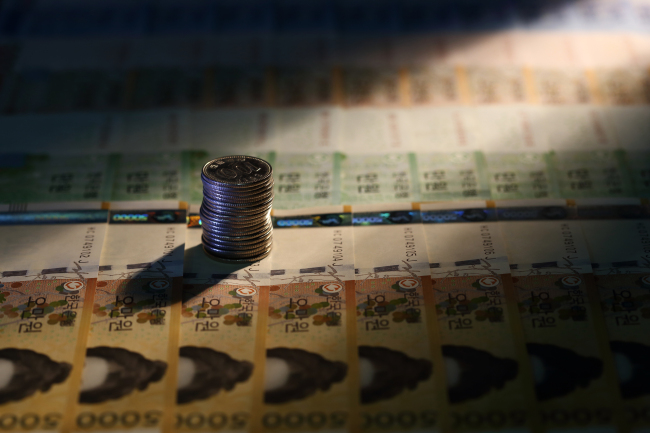In the early 2000s, Korean tourists to Turkey saw a foreign exchange rate of 1 million won to about 1.3 billion lira.
When it comes to South Korea’s economic scale, its won-denominated gross domestic product is estimated at about 1.6 quadrillion won last year, or 1,600,000,000,000,000 won. Its outstanding household debt, fully written out in the local currency, is 1,100,000,000,000,000 won.
Inbound tourists can sometimes get confused by the multiple-unit conversions such as thousands of dollars to millions of won, as outbound visitors to Turkey did before the country conducted a currency reform 10 years ago.
“When the annual meeting of the Asian Development Bank was held in May 2005 in Istanbul, it was interesting to see foreign participants or locals paid either 2 million lira in old notes or 2 lira in new notes for a bottle of water around the venue,” said an official of the Bank of Korea.

Since South Korea, in turn, issued banknotes of 5,000 won, 10,000 won and 1,000 won in the 1970s, there has been no redenomination to abbreviate the unit of the currency. The 50,000 won bill only made its debut in 2009 in the wake of the rapidly falling value of the 10,000 won bill.
A large portion of salaried workers in Korea are paid less than 50,000 euros or $56,000 per year, while most of their daily income surpasses 50,000 won.
After the 1997-98 foreign exchange crisis, the necessity of a redenomination came into the spotlight during the Roh Moo-hyun administration. But the BOK had to focus more on anticounterfeiting measures for the existing bills amid a variety of pros and cons over reform.
Early this year, Deputy Prime Minister and Finance Minister Choi Kyung-hwan cited a feasibly great uncertainty over the economy for not pushing to revamp the currency unit at the present stage.
He said the government “would prioritize revitalizing the active circulation of corporeal cash (held by the high-income bracket and the business sector) in terms of boosting the economy.”
Despite his ambiguous stance, some market insiders allege that monetary policymakers at the Finance Ministry and BOK have already completed their low-key analysis on effects of the redenomination over the past decade.
Insiders point out that South Korea is the only country among the 34 members of the Organization for Economic Cooperation and Development whose currency tops four digits per U.S. dollar. Even North Korea carried out a redenomination in 2009.
One of the key merits of a reform, analysts say, is that it would benefit Park Geun-hye administration’s goal to increase state tax revenue, which recently posted an on-year drop.
Via the change in denomination, cash hidden in the underground economy could eventually circulate into the market to change into new banknotes.
The administration had vowed to regularize the underground economy, like the unregistered private moneylending sector, which has yet to be assessed as a success or an ongoing policy.
Opponents highlight the possibility of skyrocketing inflationary pressures.
If the currency is reformed 1,000 to 1, products with a price tag of 950 won could eventually be revalued to 1 won (1,000 won in the current notes) given that they would be redenominated to 0.95 won. Critics predict more retailers will likely tend to skip decimal fractions as time goes by.
Some have raised the issue of the burden of huge costs by replacing new automated teller machines and establishing other financial information technology systems. They also cite a lack of public consensus on the move.
The country conducted a currency reform twice in the 1950s and once more in 1962 before the current unit bills were issued during the Park Chung-hee regime.
By Kim Yon-se (kys@heraldcorp.com)







![[New faces of Assembly] Architect behind ‘audacious initiative’ believes in denuclearized North Korea](http://res.heraldm.com/phpwas/restmb_idxmake.php?idx=644&simg=/content/image/2024/05/01/20240501050627_0.jpg&u=20240502093000)


![[KH Explains] Will alternative trading platform shake up Korean stock market?](http://res.heraldm.com/phpwas/restmb_idxmake.php?idx=644&simg=/content/image/2024/05/01/20240501050557_0.jpg&u=20240501161906)







